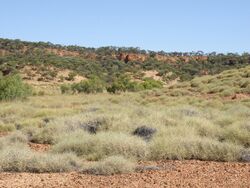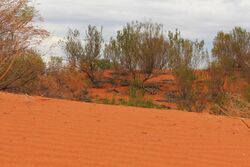Biology:Pseudonaja mengdeni
| Western brown snake | |
|---|---|

| |
| Scientific classification | |
| Domain: | Eukaryota |
| Kingdom: | Animalia |
| Phylum: | Chordata |
| Class: | Reptilia |
| Order: | Squamata |
| Suborder: | Serpentes |
| Family: | Elapidae |
| Genus: | Pseudonaja |
| Species: | P. mengdeni
|
| Binomial name | |
| Pseudonaja mengdeni (Wells & Wellington, 1985)
| |
The western brown snake (Pseudonaja mengdeni) is commonly known as Mengden's brown snake,[2] and alternatively, gwardar.[3]
Pseudnaja mengdeni is endemic to Australia . It is highly variable in colour and patterns[2] and is a highly dangerous elapid whose bite can cause severe symptoms resulting in death.[4] It is one of the three species originally classified as Pseudonaja nuchalis along with P. aspidorhyncha, and P. nuchalis.[3]
Taxonomy
Previously the western brown snake was considered a 'morph' form of Pseudonaja nuchalis, recent genetic studies have proven it to be genetically unique.[5]
It is estimated that Pseudonaja nuchalis could include in excess of 10 different species.[5] Although currently there have been 8 species chromosomeally identified species these include: P. aspidorhyncha, P. mengdeni, P. imperator, P. acutirostris, P. gowi, P. carinata, P. kellyi and P. nuchalis.[5]
Description
Pseudonaja mengdeni grows up to a total length of 2m[2] with an average length 1.2m[5] It has slender body and narrow head.[6] Mengden's brown snake is highly variable in colour and patterns, ranging from light brown to almost black.[2] However it has two distinct forms ‘Orange with black head’ or ‘Pale head, grey nape’[3] The underside along the belly is often cream, yellow, orange, or grey in colouration, frequently consisting of dark orange or grey blotches.[2]
Scales on the head often form a black V or W pattern.[6] Western brown snakes can be confused with the Eastern brown snake which has a pink mouth lining,[4] the Northern brown snake has a purplish/blue-black mouth lining.[7][8] P. mengdeni has a distinctive large strap-like scale around the front of the snout.[8] To accurately identify this species the scales around the mid-body and along the lips need to be counted. 180-230 ventral scales, 45-70 subcaudals with a divided anal scale and 17 or 19 rows of smooth mid-body scales.[2] However this must only be done by an experienced herpetologist, as a scratch from the fangs can still be fatal from P. mengdeni.[4]
Confusion between the species is largely due to the possible hybridisation between the Pseudonaja species.[3]
The western brown snake is often confused with other Pseudonaja spp. (brown snakes) and also Aspidites melanocephalus (black headed python).[3]
Distribution and habitat
Found from the coast of Western Australia through central Australia to the north-west of New South Wales and western Queensland. The species distribution is poorly defined within its northern limits[2] however it is absent from wetter areas of eastern Australia and south-western Western Australia.[9]
Pseudonaja mengdeni is practically found throughout all dry to arid areas including, woodlands, Boree woodlands, sandhill woodlands, mallee woodlands, spinifex deserts, spinifex-covered dunefields, sandplains, stony plains, croplands, grasslands and temperate sclerophyll forests.[2][10] The Western brown snake often found within fallen timber, dead trees, shrubs, native grasses and ground cavities.[4]
Diet
Pseudonaja mengdeni preys upon small reptiles, mammals, other snakes, ground nesting birds and bird eggs.[2]
Reproduction
Pseudonaja mengdeni is oviparous and can lay up to in excess of 12 eggs per clutch.[5]
Venom
Pseudonaja mengdeni has highly dangerous venom neurotoxic and haemotoxic[3] and can cause severe symptoms resulting in death.[4] Mengden's brown snake is considered dangerously venomous.[10]
Antivenom used in case of envenoming is the brown snake Antivenom[11] If bitten first aid must be applied and medical attention sought.
Behaviour
Pseudonaja mengdeni will rear their fore-body into an S-shape when threatened[10] lifting their head off the ground and open their mouth.[4] Is also a terrestrial species that is diurnal however it can be active on warm nights[4]
References
- ↑ Shea, G., Oliver, P., Wilson, S. & Ellis, R. (2017). "Pseudonaja mengdeni". IUCN Red List of Threatened Species 2017. https://www.iucnredlist.org/species/42495921/42495923. Retrieved 2021-02-13.
- ↑ 2.0 2.1 2.2 2.3 2.4 2.5 2.6 2.7 2.8 Cogger, Harold (2014). Reptiles and Amphibians of Australia (7th ed.). Australia: CSIRO Publishing. p. 926. ISBN 9780643100350.
- ↑ 3.0 3.1 3.2 3.3 3.4 3.5 Beatson, Cecilie. "Animal Species: Western Brown Snakes (nuchalis-complex)". Australian Museum. http://australianmuseum.net.au/Western-Brown-Snakes. Retrieved 10 October 2014.
- ↑ 4.0 4.1 4.2 4.3 4.4 4.5 4.6 Michael, Damian; Lindenmayer, David (2010). Reptiles of the NSW Murray Catchment, A Guide to Their Identification, Ecology, and Conservation. Australia: CSIRO Publishing. pp. 206–207. ISBN 9780643098206. https://archive.org/details/reptilesnswmurra00mich.
- ↑ 5.0 5.1 5.2 5.3 5.4 Wells, Richard (2002). "Taxonomy of the genus Pseudonaja (Reptilia: Elapidae) in Australia". Australian Biodiversity Record (7): 8. ISSN 1325-2992. http://www.kingsnake.com/aho/pdf/menu2/wells2002.pdf.
- ↑ 6.0 6.1 Edwards, Belinda (2011). Australian Snakes a Pictorial Guide. Australia: The Five Mile Press Pty Ltd. p. 63. ISBN 9781742116181.
- ↑ Swan, Gerry; Shea, Glenn; Sadlier, Ross (2004). A Field Guide to Reptiles of New South Wales (2nd ed.). Australia: Reed New Holland. p. 256. ISBN 187706906X.
- ↑ 8.0 8.1 Swan, Gerry; Wilson, Steve (2008). What Snake is that? Introducing Australian Snakes. Australia: Reed New Holland. p. 80. ISBN 9781877069574.
- ↑ Queensland Museum. "Western Brown Snake". Queensland Museum. http://www.qm.qld.gov.au/Find+out+about/Animals+of+Queensland/Reptiles/Snakes/Common+and+dangerous+species/Western+Brown+Snake#.VDhm8vmSyDE. Retrieved 10 October 2014.
- ↑ 10.0 10.1 10.2 Wilson, Steve; Swan, Gerry (2008). A Complete Guide to Reptiles of Australia (2nd ed.). Australia: New Holland Publishers. pp. 458–462. ISBN 9781877069468.
- ↑ The University of Adelaide. "CSL Brown Snake Anitvenom". The University of Adelaide. http://www.toxinology.com/generic_static_files/cslavh_antivenom_brown.html#basic. Retrieved 10 October 2014.
Wikidata ☰ Q3409783 entry





